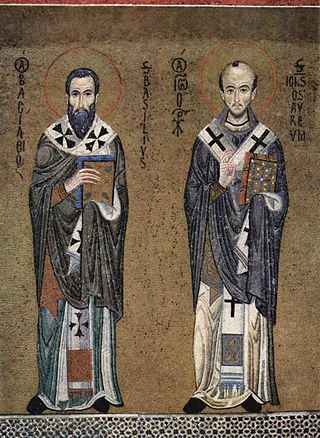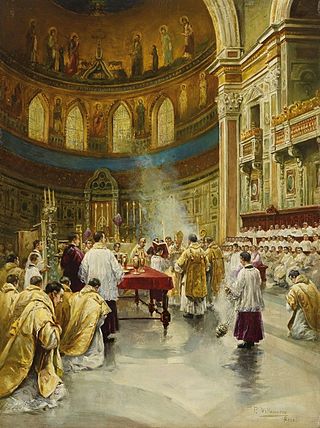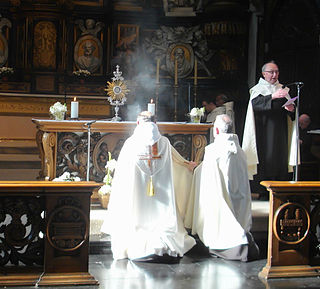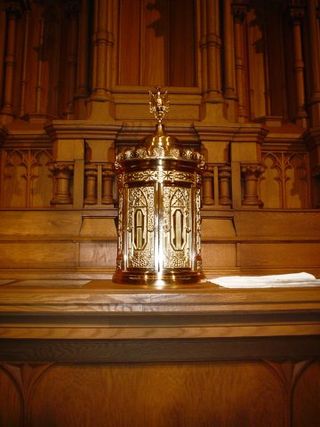Related Research Articles

The Roman Missal is the title of several missals used in the celebration of the Roman Rite. Along with other liturgical books of the Roman Rite, the Roman Missal contains the texts and rubrics for the celebration of the most common liturgy and Mass of the Catholic Church.

Mass is the main Eucharistic liturgical service in many forms of Western Christianity. The term Mass is commonly used in the Catholic Church, Western Rite Orthodoxy, Old Catholicism, and Independent Catholicism. The term is used in some Lutheran churches, as well as in some Anglican churches. The term is also used, on rare occasion, by other Protestant churches.

The Mass of Paul VI, also known as the Ordinary Form or Novus Ordo, is the most commonly used liturgy in the Catholic Church. It was promulgated by Pope Paul VI in 1969 and published in 1970; it was then revised in 1975, further revised by Pope John Paul II in 2000, and published in a third edition in 2002.

The Tridentine Mass, also known as the Traditional Latin Mass or the Traditional Rite, is the liturgy in the Roman Missal of the Catholic Church published from 1570 to 1962. Celebrated almost exclusively in Ecclesiastical Latin, it was the most widely used Eucharistic liturgy in the world from its issuance in 1570 until the introduction of the Mass of Paul VI.

Divine Liturgy or Holy Liturgy is the Eucharistic service of the Byzantine Rite, developed from the Antiochene Rite of Christian liturgy which is that of the Ecumenical Patriarchate of Constantinople. As such, it is used in the Eastern Orthodox, the Greek Catholic Churches, and the Ukrainian Lutheran Church. Although the same term is sometimes applied in English to the Eucharistic service of Armenian Christians, both of the Armenian Apostolic Church and of the Armenian Catholic Church, they use in their own language a term meaning "holy offering" or "holy sacrifice". Other churches also treat "Divine Liturgy" simply as one of many names that can be used, but it is not their normal term.

Holy Week is the most sacred week in the liturgical year in Christianity. For all Christian traditions it is a moveable observance. In Eastern Christianity, which also calls it Great Week, it is the week following Great Lent and Lazarus Saturday, starting on the evening of Palm Sunday and concluding on the evening of Great Saturday. In Western Christianity, Holy Week is the sixth and last week of Lent, beginning with Palm Sunday and concluding on Holy Saturday.

The Feast of Corpus Christi, also known as the Solemnity of the Most Holy Body and Blood of Christ, is a Christian liturgical solemnity celebrating the Real Presence of the Body and Blood, Soul and Divinity of Jesus in the elements of the Eucharist; it is observed by the Roman Catholic Church, in addition to certain Western Orthodox, Lutheran, and Anglican churches. Two months earlier, the institution of the Eucharist at the Last Supper is observed on Maundy Thursday in a sombre atmosphere leading to Good Friday. The liturgy on that day also commemorates Christ's washing of the disciples' feet, the institution of the priesthood, and the agony in the Garden of Gethsemane.

The Paschal Triduum or Easter Triduum, Holy Triduum, or the Three Days, is the period of three days that begins with the liturgy on the evening of Maundy Thursday, reaches its high point in the Easter Vigil, and closes with evening prayer on Easter Sunday. It is a moveable observance recalling the Passion, Crucifixion, Death, burial, and Resurrection of Jesus, as portrayed in the canonical Gospels.
Easter Vigil, also called the Paschal Vigil or the Great Vigil of Easter, is a liturgy held in traditional Christian churches as the first official celebration of the Resurrection of Jesus. Historically, it is during this liturgy that people are baptized and that adult catechumens are received into full communion with the Church. It is held in the hours of darkness between sunset on Holy Saturday and sunrise on Easter Day – most commonly in the evening of Holy Saturday or midnight – and is the first celebration of Easter, days traditionally being considered to begin at sunset.

In Christianity, worship is the act of attributing reverent honour and homage to God. In the New Testament, various words are used to refer to the term worship. One is proskuneo which means to bow down to God or kings.

Eucharistic discipline is the term applied to the regulations and practices associated with an individual preparing for the reception of the Eucharist. Different Christian traditions require varying degrees of preparation, which may include a period of fasting, prayer, repentance, and confession.

The Chrism Mass is a religious service held in certain Christian denominations, such as Roman Catholicism, Lutheranism, and Anglicanism. It is usually celebrated each year on Maundy Thursday or on another day of Holy Week. During the ceremony, the holy oils used for sacraments and rituals are blessed or consecrated.

The Roman Rite is the most common ritual family for performing the ecclesiastical services of the Latin Church, the largest of the sui iuris particular churches that comprise the Catholic Church. The Roman Rite governs rites such as the Roman Mass and the Liturgy of the Hours as well as the manner in which sacraments and blessings are performed.

In the Roman Rite of the Catholic Church, Lutheranism, Methodism and Anglicanism, an altar bell is typically a small hand-held bell or set of bells. The primary reason for the use of such bells is to create a “joyful noise to the Lord” as a way to give thanks for the miracle taking place atop the altar.

Benediction of the Blessed Sacrament, also called Benediction with the Blessed Sacrament or the Rite of Eucharistic Exposition and Benediction, is a devotional ceremony, celebrated especially in the Roman Catholic Church, but also in some other Christian traditions such as Anglo-Catholicism, whereby a bishop, priest, or a deacon blesses the congregation with the Eucharist at the end of a period of adoration.
In the history of Christianity, the African Rite refers to a now defunct Christian, Latin liturgical rite, and is considered a development or possibly a local use of the primitive Roman Rite. Centered around the Archdiocese of Carthage in the Early African church, it used the Latin language.

During the Mass of the Faithful, the second part of the Mass, the elements of bread and wine are considered to have been changed into the veritable Body and Blood of Jesus Christ. The manner in which this occurs is referred to by the term transubstantiation, a theory of St. Thomas Aquinas, in the Roman Catholic Church. Members of the Orthodox, Anglican, and Lutheran communions also believe that Jesus Christ is really and truly present in the bread and wine, but they believe that the way in which this occurs must forever remain a sacred mystery. In many Christian churches some portion of the consecrated elements is set aside and reserved after the reception of Communion and referred to as the reserved sacrament. The reserved sacrament is usually stored in a tabernacle, a locked cabinet made of precious materials and usually located on, above, or near the high altar. In Western Christianity usually only the Host, from Latin: hostia, meaning "victim", is reserved, except where wine might be kept for the sick who cannot consume a host.

The Mass is the central liturgical service of the Eucharist in the Catholic Church, in which bread and wine are consecrated and become the body and blood of Christ. As defined by the Church at the Council of Trent, in the Mass "the same Christ who offered himself once in a bloody manner on the altar of the cross, is present and offered in an unbloody manner". The Church describes the Mass as the "source and summit of the Christian life", and teaches that the Mass is a sacrifice, in which the sacramental bread and wine, through consecration by an ordained priest, become the sacrificial body, blood, soul, and divinity of Christ as the sacrifice on Calvary made truly present once again on the altar. The Catholic Church permits only baptised members in the state of grace to receive Christ in the Eucharist.

The Mass of the Lord's Supper, also known as A Service of Worship for Maundy Thursday, is a Holy Week service celebrated on the evening of Maundy Thursday. It inaugurates the Easter Triduum, and commemorates the Last Supper of Jesus with his disciples, more explicitly than other celebrations of the Mass.
Mediator Dei is a papal encyclical issued by Pope Pius XII on 20 November 1947. It was the first encyclical devoted entirely to liturgy.
References
- ↑ Mitchell, Nathan (1990). Cult and Controversy: The Worship of the Eucharist Outside Mass. Cellegeville, Minnesota: The Liturgical Press. p. 237. ISBN 9780814660508 . Retrieved 4 September 2017.
- ↑ Coppa, Frank J. (2013). The Life and Pontificate of Pope Pius XII: Between History and Controversy. Catholic University of America Press. p. 229. ISBN 9780813220161 . Retrieved 4 September 2017.
- 1 2 Pecklers, Keith F. (2003). Dynamic Equivalence: The Living Language of Christian Worship. Liturgical Press. pp. 31ff. ISBN 9780814661918 . Retrieved 5 September 2017.
- ↑ Laurence, John D. (2012). The Sacrament of Eucharist. Liturgical Press. p. 96. ISBN 9780814635308 . Retrieved 4 September 2017. The document was De musica sacra et sacra liturgia (Sacred Music and Liturgy).
- ↑ Cummings, Owen F. (2013). Eucharist and Ecumenism: The Eucharist across the Ages and Traditions. Eugene, Oregon: Pickwick Publications. p. 118. ISBN 9781620327593 . Retrieved 4 September 2017.
- ↑ D'Antonio, William V.; Dillon, Michele; Gautier, Mary L. (2013). American Catholics in Transition. Rowman & Littlefield. p. 17. ISBN 9781442219939 . Retrieved 4 September 2017.
- ↑ Cohalan, Florence D. (1999). A Popular History of the Archdiocese of New York. United States Catholic Historical Society. p. 311.
- ↑ AAS 1950, 795
- ↑ AAS 1944, 44
- ↑ AAS 1957, 425
- ↑ AAS 1952, 542-546
- ↑ 7 16, 1942, AAS, 1942
- ↑ AAS 1946, 349-354
- ↑ De solemni vigilia paschali instauranda, early March 1951
- ↑ "Maxima Redemptionis", November 16, 1955
- ↑ AAS 1956, 153; De Solemni Vigilia Paschali Instauranda. AAS 1951, 128-137
- ↑ Bradshaw, 162-163
- ↑ Regan, Patrick (2012). Advent to Pentecost: Comparing the Seasons in the Ordinary and Extraordinary Forms of the Roman Rite. Liturgical Press. p. 211. ISBN 9780814662793 . Retrieved 5 September 2017.
- ↑ Prendergast, Michael R. (2004). Voices from the Council. Pastoral Press. p. 152.
- ↑ Ferrone, Rita (2007). Liturgy: Sacrosanctum Concilium. Paulist Press. p. 112. ISBN 9780809144723 . Retrieved 5 September 2017.
- ↑ "St. Patrick's Will Conduct the Liturgical Services as Just Decreed by Pope" (PDF). New York Times. 15 April 1957. Retrieved 5 September 2017. Spellman's cathedral scheduled the Easter Vigil for 6 pm with Mass to follow at 7 pm.
- ↑ Reid, Alcuin (2005). The Organic Development of the Liturgy (2nd ed.). Ignatius Press. p. 233. ISBN 9781586171063 . Retrieved 5 September 2017.
- ↑ Bertoniere, 45
- ↑ Laughlin, Corinna; Seaman, Kristopher; Palanca, Stephen (2016). Guide for Celebrating Holy Week and the Triduum. Liturgy Training Publications. p. 9. ISBN 9781616712921 . Retrieved 5 September 2017.
- ↑ Mudge, Lewis S. (2012). "Chapter 18: Christian Ecumenism and the Abrahamic Faith". In Kireopoulos, Antonios; Mecera, Juliana (eds.). Ecumenical Directions in the United States Today: Churches on a Theological Journey. Paulist Press. ISBN 9780809147557 . Retrieved 13 January 2018.
- ↑ Fisher, Eugene J. (2005). "Catholic Teaching on Jews and Judaism: An Evolution in Process". In Boys, Mary C. (ed.). Seeing Judaism Anew: Christianity's Sacred Obligation. Rowman & Littlefield. p. 253. ISBN 9781461635956 . Retrieved 1 March 2018.
- ↑ Cabié, Robert (1986). The Eucharist. The Liturgical Press. p. 226. ISBN 9780814613641 . Retrieved 4 September 2017.
Sources
- Acta Apostolicae Sedis, (AAS) Roma, Vaticano 1939-1959
- Mediator Dei, Acta Apostolicae Sedis, (AAS) Roma, Vaticano 1947, 521 ff
- Gabriel Bertoniere, The Historical Development of the Easter Vigils in the Greek Church and Related Services, Rome, 1972
- Paul Bradshaw, The New Westminster Dictionary of Liturgy and Worship, 2005
- Cyril Korolevsky, Living Languages in Catholic Worship: An Historical Inquiry, 1957
